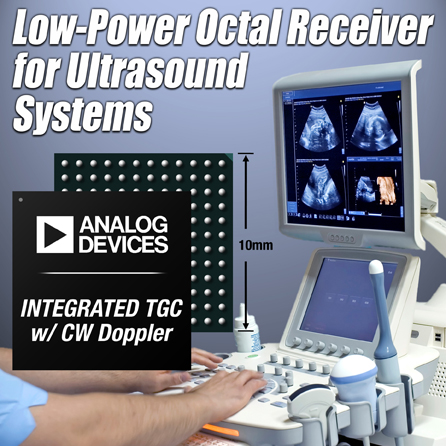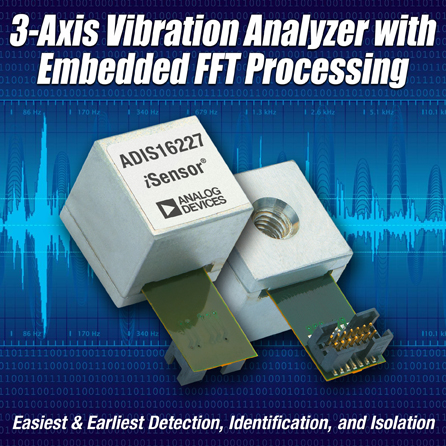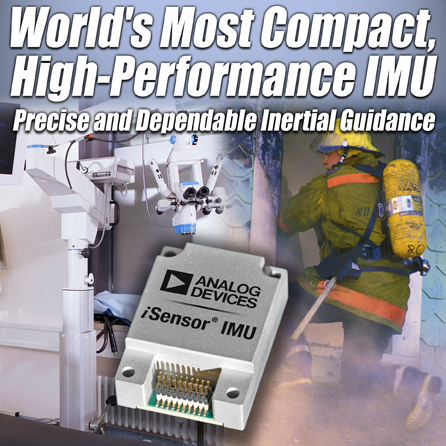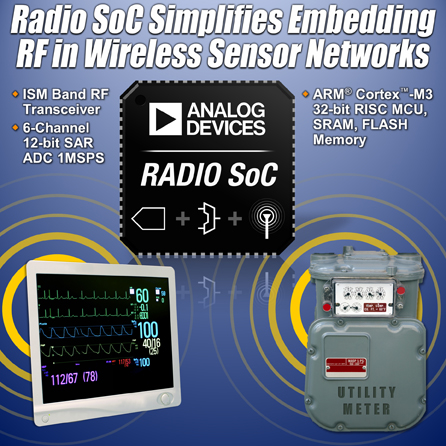Author:
Reported by Cliff Keys, Editorial Director, Editor-in-Chief, Power Systems Design
Date
11/25/2010
I had the opportunity of an interview with Peter Henry, Vice President responsible for power management operations for Analog Devices. He have me an overview if the company's latest announcements at the show.
Analog Devices, Inc. released the industry's first fully differential attenuating precision amplifier. The AD8475 amplifier solves a common problem in industrial, instrumentation and medical applications where signals up to �10V are interfaced to single-supply ADCs. The AD8475 is capable of driving ADCs (analog-to-digital converters) with up to 18 bits of resolution and 4-MSPS (million sample per second) throughput with high accuracy and low power consumption. This amplifier features selectable attenuating gains of 0.4x and 0.8x and level shifting for differential inputs up to �12 V. The AD8475 is effective for driving low-voltage, high-precision differential input SAR ADCs in high-voltage applications, while saving board space and lowering power consumption.

Analog Devices, Inc., launched the fourth generation of its award-winning octal (eight-channel) ultrasound receivers with the introduction of two new ICs that reduce system size, complexity, and power consumption for high-end, mid-range, and portable ultrasound systems. The need for smaller, faster, lower-power ultrasound equipment continues to grow as hospitals, medical clinics, and medical emergency units increasingly rely on more sophisticated ultrasound equipment for providing diagnostic imaging. InMedica, the medical research division of IMS Research, predicts worldwide ultrasound revenues will grow from $4.9 billion in 2009 to more than $6 billion by 2012. The new AD9278 and AD9279 receiver chips each integrate ADI's world-leading data conversion technology for low noise TGC (time-gain-control) mode performance while providing high dynamic range I/Q demodulators that reduce the power and area for implementation of CW (continuous wave) Doppler processing. The new octal ultrasound receivers provide the highest available output-referred large-signal SNR--up to 67dB--enabling improved sensitivity in diagnostic ultrasound systems while reducing board space up to 40 percent. "Ultrasound equipment designers must continually balance new and changing demands for higher image quality and increased power efficiency," said Patrick O'Doherty, vice president for the Healthcare Group, Analog Devices. "The new AD9278 and AD9279 octal ultrasound receivers help system designers manage the design challenges inherent in trying to get the best image quality at the lowest power for either high-end or portable systems." The AD9278 octal ultrasound receiver is designed for portable ultrasound systems while the AD9279 octal ultrasound receiver is suitable for high-end and mid-range systems. The devices are pin- and package-compatible with each other and allow designers to use a common PCB (printed circuit board) layout that can be leveraged across multiple ultrasound platforms to save development time and cost. Products in Analog Devices' octal ultrasound receiver portfolio include the AD9271, which, when unveiled in April 2007, was the first device to integrate a complete octal ultrasound receiver on a single chip, and is used today in ultrasound equipment throughout the world. Other octal ultrasound receivers include the AD9272 for high-and mid-range cart-based ultrasound equipment, AD9273 for portable ultrasound systems, and the AD9276 and AD9277 that enable high-quality CW (continuous wave) Doppler processing. AD9278 and AD9279 octal ultrasound receivers key features and benefits: The new AD9278 and AD9279 octal ultrasound receivers feature a variable gain range of 45dB, a fully differential signal path, an active input preamplifier termination, a maximum gain of up to 52dB, and an ADC (analog-to-digital converter) with a conversion rate of up to 80 MSPS. Each device is optimized for dynamic performance and low-power operation in applications where a small package size is critical. In CW mode, the AD9278 features ultra-low power consumption of 25 mW per channel, while the AD9279 offers low power consumption of 50 mW per channel. In TGC mode, the AD9278 consumes only 88 mW per channel at 40 MSPS, and the AD9279 consumes only 139 mW per channel at 40 MSPS. For high-end systems, the AD9279 offers a highly configurable LNA featuring low input-referred noise density of 0.67nV/?Hz. Download the AD9278 or AD9279 data sheet and order samples. Additional features and benefits include:

Analog Devices, Inc. is helping industrial equipment designers improve system performance and maintenance costs through vibration detection/isolation/correction. With the announcement of the new ADIS16227 iSensor® vibration monitor, equipment designers have a fully integrated vibration analysis solution capable of autonomous operation. This enables the earliest detection, identification, and isolation of possible vibration sources from equipment and bearing wear that can lead to less precise operation or equipment downtime. By embedding these small vibration monitors, applications ranging from wind turbines to precision factory automation and assembly equipment will benefit from automatic vibration profiling. MEMS accelerometers are well suited for vibration monitoring, but are typically at a low level of integration. With decades of integrated sensor processing experience, Analog Devices transformed a MEMS accelerometer into a 3-axis vibration analyzer with programmable embedded processing. The ADIS16227 iSensor vibration monitor eliminates the complexity and risk of developing with multiple components and enables a much wider application base. "For the first time, industrial equipment designers have an easy-to-use, affordable and complete sugar-cube sized vibration analyzer," said Bob Scannell, iSensor business development manager, MEMS/Sensors Group, Analog Devices. "With the ADIS16227, developers have access to proven 4th-generation vibration sensing capability with frequency domain processing programmability and tuning that greatly improves the ability to isolate the vibration source quickly." Key high-performance features and benefits:

Analog Devices, Inc. is helping industrial and medical equipment manufacturers more easily implement motion capture and control features by adding two highly integrated precision MEMS (micro-electro-mechanical system) inertial sensors to its iSensor® motion sensor product portfolio. The new ADIS16334 and ADIS16375 IMUs (inertial measurement units) achieve the accuracy and ease-of-use required to quickly embed navigation, tracking, guidance, instrument control, platform stabilization and other six-degree-of-freedom sensing functions in equipment ranging from industrial process controls to precision medical instrumentation. The ADIS16334 is 40 percent smaller than previous-generation IMUs and is optimized for high-density, space-limited applications, while the ADIS16375 is ADI's highest performance IMU with 0.003 o/sec gyro stability. "For many equipment designers, high-performance motion sensing was difficult to realize due to the relatively low level of integration and performance of commercial-grade inertial sensors," said Bob Scannell, iSensor business development manager, MEMS/Sensors Group, Analog Devices. "With today's expansion of our iSensor IMU portfolio, ADI is helping designers more easily improve performance by providing the most compact high-performance IMUs available, while continuing to offer unmatched environmental ruggedness and simplicity of implementation, helping bring entirely new inertial applications such as surgical tool guidance to market in record time." Unlike most other industrial IMUs, these devices require no additional integration, test, or calibration. Only power and an industry standard SPI interface are needed to easily deliver accurate data out-of-the-box, even in the most challenging environments. ADIS16375 and ADIS16334 high-performance features and benefits: ADI's iSensor IMU portfolio has been widely adopted by OEM designers in the industrial and medical markets. The new ADIS16375 and ADIS16334 are the third generation of ADI's high-performance IMUs and feature unmatched performance, feature-sets, and ease-of-use when operating within environments characterized by severe vibration, shock, and high temperatures. They both feature:

Analog Devices, Inc. introduced a SoC (system-on-chip) device that integrates all of the RF (radio frequency) transmit and receive functions, data conversion, and processing elements required to enable a fully programmable radio. Designed for a range of remote, battery-powered wireless sensor network (WSN) applications, including utility meters, medical telemetry systems, building automation, asset tracking and security systems, the ultra-low-power ADuCRF101 radio SoC features a 12-bit, 1Msps ADC (analog-to-digital converter), a 32-bit ARM® Cortex™-M3, on-chip SRAM and FLASH memory and an ISM-band radio transceiver. "By combining converter technology, low-power 32-bit processing, on-chip memory and high-performance RF communications in a single 9-mm × 9-mm package, the ADuCRF101 provides a radio SoC at a performance level not previously available to battery-powered WSN applications," said James Caffrey, Converter Group marketing and applications director, Analog Devices. "By delivering a solution based on an ARM® Cortex™-M3, combined with evaluation hardware and software tools, the Analog Devices platform simplifies design and reduces development time for our customers who are designing wireless data-acquisition products." The ADuCRF101 radio SoC extends ADI's Precision Analog Microcontroller portfolio, which now includes an ultra-low-power offering based on the ARM®Cortex™-M3, to support the demanding design requirements of today's remote sensing and measurement applications. Design engineers can visit ADI's EngineerZone, an open technical support forum where they can ask questions, share knowledge and search for answers to questions regarding Precision Analog Microcontrollers. ADuCRF101 lowers power in a wide range of applications The network range and coverage of the ADuCRF101 radio SoC is well suited to applications where data must be captured, measured, and transmitted quickly in noisy environments without taxing battery life. "With the ADuCRF101 radio SoC, ADI now gives energy metering customers the option of designing with their own processor alongside ADI's ISM-band transceivers or choosing a fully integrated SoC," said Ronn Kliger, Energy Group director, Analog Devices. "The new device is an important addition to our energy portfolio, which includes products ranging from single- and poly-phase metering ICs to a variety of integrated RF transceivers. The ADuCRF101 also delivers a single-chip communications solution for the challenging requirements of battery powered gas, water and heat meters." In medical patient monitoring systems, a wireless Holter or telemetry monitor worn by the patient needs to be small, operate at low power for extended battery life, and offer the performance level to sustain uninterrupted communication of the patient's vital signs. The ADuCRF101 enables these applications and also provides a platform upon which patient monitoring outside of the hospital environment can be done. More about the ADuCRF101 Radio SoC The ADuCRF101 radio SoC's 32-bit ARM® Cortex™-M3 provides the throughput necessary to support a growing array of sensing and measurement functions, and features serial download and debug, a wake-up timer with RC oscillator and optional external watch crystal, a 16-MHz oscillator with an 8-way programmable divider. The integrated RF transceiver provides a combination of industry-leading interference blocking performance with very low receive and transmit currents, allowing more robust operation in urban environments where interfering signals are present. The ADuCRF101 device is supported by a new suite of ADI development tools, which include "MiniKit" evaluation boards with matching antennae, an emulator and local communication "InterfaceBoard" for serial-wire program download and debug support, ADuCRF101-specific compilers, as well as CMSIS (Cortex Microcontroller Software Interface Standard) compliant software libraries to support all peripherals. Also available are a power/battery-life calculator and RF low-level drivers and evaluation tools. The ADuCRF101 radio SoC supports DASH7™ — a coalition of organizations promoting a standard for versatile wireless sensor networks at 433 MHz that is based on the ISO-18000-7 standard. The ADuCRF101 additionally boasts long range, good penetration and low power and also supports 802.15.4-based networks. www.analog.com